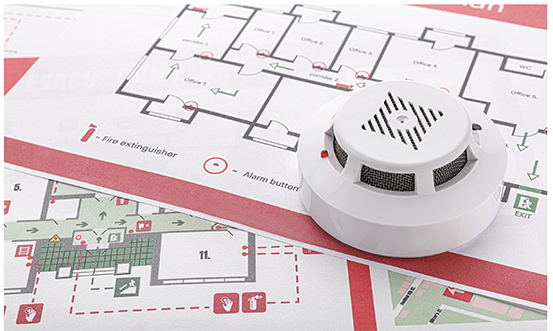Be Prepared: Maintenance of Fire and Life Safety Systems Starts with the Property Management Team

Here’s a checklist for keeping your fire and life safety systems ready in the event of a disaster.
By Steve Goyette, Vice President, Telgian Fire Safety Services
Fire and life safety for small apartment buildings includes a wide variety of measures, many of which are more than capably handled by on-site management personnel. Here are some general categories to consider, along with specific actions that can improve preparedness in the event of an emergency.
Fire Extinguishers
Monthly – Perform a visual inspection to ensure visibility / accessibility of the extinguisher, presence and correct position of the locking pin and an unbroken tamper seal. Inspect the extinguisher for any physical damage, leakage, corrosion, or a clogged hose or nozzle. Inspect the pressure gauge to ensure it is in the correct operating range. Pick up the extinguisher to ensure it is full, placing it back in the correct position when done, which includes making sure the stickers (typically “how to use” the extinguisher) are legible and facing outwards. Check the extinguisher tag and note when the annual inspection is coming due, then initial and date the back of the tag.
Annually – Hire a licensed contractor to perform an annual fire extinguisher inspection, which will likely include additional services (such as 6-yr and 12-yr) on some of the extinguishers in service.
Exit Signs / Emergency Lighting
Monthly –Perform a visual inspection to ensure the units are mounted correctly, have no obvious signs of damage, and the lenses are clear and unbroken. In addition, perform the “push button” test by holding down the test button for 30 seconds. During this time, the device should light up with full display, and if not, the unit should be serviced by a licensed contractor. Update the inspection log with results and any noted items requiring repair.
Annually – Hire a licensed contractor to perform an annual emergency light/exit sign inspection, which may require additional services such as batteries, bulbs, or light fixtures for those that do not pass the inspection and test.
Housekeeping and Landscaping
Regular upkeep and maintenance of the property is crucial to allowing for an effective prevention of fire, as well as response when an emergency does occur. Be sure plants and landscaping are well trimmed and not impacting egress pathways, dead and down foliage is regularly removed from the property, common hallways and walkways are clean and free of debris/storage to maximize exit space for residents, and that stair rails and steps are in good condition with proper lighting.
Exit / Stair Doors
In some cases these doors are connected to the fire alarm system, or local smoke alarms, and are intended to close in the event of smoke or fire to prevent the effects of the fire (smoke / heat) from entering the exit path for residents. Ensure these exit and stairway doors remain functional and latch fully. Do not block or lock any exit and stairway doors. It is critical that they open and close normally.
Fire Alarm Systems
For those facilities equipped with a fire alarm system, there are a few key inspections that a property manager can conduct, in between inspections from the licensed contractor, that help to ensure the system will be ready in the event of a fire.
Weekly – Perform a visual inspection of the fire alarm control panel to ensure that the power indication lamp is on, and that there are no trouble signals, supervisory signals or alarm signals. In addition, weekly visual inspection of the notification devices (horns, strobe lights, combination horn/strobe) to ensure they’re mounted securely and free from obvious physical damage.
Semiannually – Hire a licensed contractor to perform a semiannual and annual fire alarm inspections.
Fire Sprinkler Systems
For those facilities equipped with a fire sprinkler system, there are a few key inspections that a property manager can conduct, in between inspections from the licensed contractor, that help to ensure the system will be ready in the event of a fire.
Monthly – Perform a visual inspection of the water pressure gauges on all risers to ensure proper pressure and absence of closed valves in the system. Also, perform a visual inspection of alarm and dry pipe valves to ensure they’re free from physical damage and corrosion.
Weekly or Monthly – Perform a visual inspection of all fire sprinkler system control valves to ensure they’re in the proper open position and are free from physical damage and corrosion. Perform inspections weekly for those only secured with a tamper seal, and monthly for those secured with a lock, or if supervised by a fire alarm system.
Telgian Fire Safety Vice President of Business Development, Steve Goyette, CFPS, SET, has over 35 years of experience in fire protection design and consulting, including fire sprinkler contracting. He is a Certified Fire Protection Specialist (CFPS), as well as Level III NICET certified in Automatic Sprinkler System Layout. Steve Goyette can be reached at sgoyette@telgian.com.




